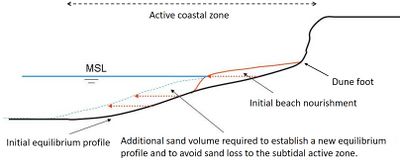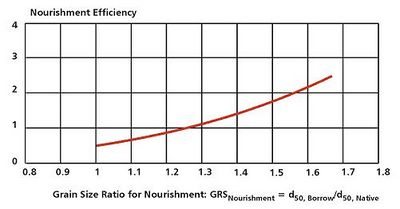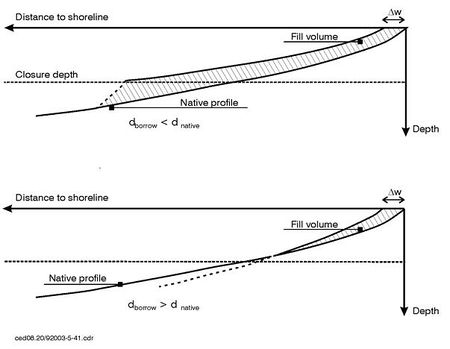Difference between revisions of "Beach nourishment"
Dronkers J (talk | contribs) |
Dronkers J (talk | contribs) |
||
| Line 1: | Line 1: | ||
| + | {{Definition|title=Beach nourishment | ||
| + | |definition=Artificial sand supply to the beach with sand imported from a source outside the [[active coastal zone]].}} | ||
| − | + | ==Purpose of beach nourishment== | |
| − | + | Shore nourishments can be applied in various cases; e.g.: | |
| − | + | #to broaden the beach (recreation purposes); | |
| + | #to create entirely new beaches (recreation purposes); | ||
| + | #to enhance the safety of the mainland or to enhance the safety of properties built rather close to the edge of the dunes; | ||
| + | #to compensate losses because of [[structural erosion]]. | ||
| + | The first three cases can be regarded as applications to improve an existing undesirable situation that does not necessarily imply an ongoing supplementation programme. | ||
| + | In the fourth case, coastal nourishments are used as an instrument in coastal protection projects. Due to [[structural erosion]], sediments are lost more or less continuously from a stretch of coast; regular nourishments are required to compensate for the losses that occur on average. | ||
| − | + | ==Non-equilibrium coastal profile== | |
| − | |||
| − | |||
| − | + | [[File:EquilibriumNourishment.jpg|thumb|right|400px|<small>Fig. 1. Morphological response to beach broadening, assuming initial equilibrium. After nourishment, the coastal profile is out of equilibrium unless the entire active coastal zone is nourished. Beach broadening implies seaward growth of the front dune that will trap part of the beach sand. So nourishment is still necessary.</small>]] | |
| + | When borrow sand is placed in a coastal profile, in general neither the profile nor the grain size distribution will be in equilibrium. Nature will try to restore an equilibrium profile, so that there will always be changes in the nourished profile, as illustrated in Fig. 1. There will also be changes caused by alongshore distribution of the nourishment, by a possible trend of sustained long-term erosion or by the response to extreme weather events. In practice it is not possible to carry out stable nourishments in the short or long term on an eroding coast. Nourishments are inherently unstable on eroding coastlines. These are basic realities that are often difficult for the public, politicians and those who fund the projects to accept. On the other hand, as environmental concerns and requirements for sustainability gain in importance, the share of nourishment in coastal management schemes has gradually increased in recent decades. | ||
| + | When a beach suffers from structural erosion, artificial nourishments can be applied as a soft remedy. The losses occurring from a stretch of coast are replenished from time to time. The regular application of nourishments with borrow sand with the same grain size as the native beach material will not strongly disturb the existing longshore sediment transport and thus will not change the occurring losses. Therefore the erosion will not stop; this means that after a certain period of time (the nourishment lifetime) the nourishment must be repeated. | ||
| − | |||
| − | + | ==Nourishment design: Experience from Denmark== | |
| + | The performance of a nourishment scheme very much depends on the grain size of the borrow material relative to the grain size of the native material. The influence of grain size on cross-shore sediment transport processes is discussed in the article [[Coastal Hydrodynamics And Transport Processes]]. | ||
| − | + | If the borrow sand is finer than the native sand, it will tend to form a flatter profile than the natural one. The equilibrium reshaping of the nourished sand will reach out to the closure depth. If the objective of the nourishment is to obtain a wider beach, this will require large volumes of sand, as illustrated in the upper part of Fig. 2. | |
| + | If the objective is to reduce the required nourishment volume while retarding subsequent erosion (increasing the nourishment lifetime) it is advantageous to apply sand with a larger grain size than that of the native sand into a coastal profile. This will produce a steeper profile than the natural profile. Furthermore, coarser sand will be more stable in terms of longshore loss. This '''nourishment efficiency''' of the nourished sand has been studied by the Danish Coastal Authority based on many years of nourishment along the Danish North Sea Coast<ref name="Vestkysten">Vestkysten 2000 (in Danish) (The West Coast or the Danish North Sea Coast 2000), The Danish Coastal Authority.</ref>. The nourishment efficiency is defined as the ratio between the erosion rate for the natural sand (theoretical) and that of the nourished sand. The nourishment efficiency has been analysed as function of the ratio between the mean grain size of the borrow sand and that of the native sand: | ||
| + | :<math>GSR_{Nourishment}=d_{50,Borrow}/d_{50,Native}</math> | ||
| + | The analysis covers effects of cross shore as well as longshore effects. The results are expressed as a relation between the nourishment efficiency versus the grain size ratio <math>GSR_{Nourishment}</math>. It is evident from the relation shown in Fig. 3. that the Nourishment Efficiency increases considerably with increasing Grain Size Ratio for Nourishment. | ||
| − | + | {| border="0" align="center" | |
| + | |- | ||
| + | | valign="top"| | ||
| + | [[File:nourished beaches equilibrium.jpg|450px|right|thumb|<small>Fig. 2. Equilibrium conditions for nourished beaches required to obtain an additional beach width of δw with borrow sand, which is finer and coarser than the native sand (upper and lower, respectively). </small>]] | ||
| + | | valign="top"| | ||
| + | [[Image:nourish grain size.jpg|400px|thumb|right|<small>Fig. 3. Relation between Nourishment Efficiency and the Grain Size Ratio for Nourishment<ref name="Vestkysten"/></small>]] | ||
| + | |} | ||
<br clear=all> | <br clear=all> | ||
| + | |||
| − | ==Nourishment | + | ==Nourishment design: Experience from the Netherlands<ref name=B>Brand, E., Ramaekers, G. and Lodder, Q. 2022. Dutch experience with sand nourishments for dynamic coastline conservation – An operational overview. Ocean and Coastal Management 217, 106008</ref>== |
| − | |||
| − | + | [[File:NourishmentLife.jpg|thumb|right|300px|Fig. 4. Lifespan of beach nourishments compared to the nourishment volume<ref name=B/>.]] | |
| − | [[File: | ||
| − | |||
| − | + | Beach nourishments are regularly carried out along the Dutch coast in order to maintain the coastline in all the sections that are subject to erosion. In total 258 beach nourishments have been carried out since 1990. From the experience of these nourishments some rule of thumbs have been derived to optimize their effectiveness. | |
| − | + | Sand is borrowed from the seabed of the southern North Sea which mainly consists of thick sand deposits. Sand is mined within a distance of 12 miles from the coast to limit shipping distances, but below the 20 m depth contour to avoid an influence on coastal processes. Borrow sites are selected for grain sizes similar to the sand of the beach where the nourishment is to be applied. | |
| − | + | Beach nourishments are placed against the dune foot which is approximately at NAP +3 m. After a short beach platform the sand placement descends with a slope around 1:30 that is as similar to the natural beach profile. The average volume of beach nourishments is 200 m<sup>3</sup>/m and the average length is 2.3 km with a gradual decrease in volume towards both ends of the nourishment in the alongshore direction to minimize side effects. With this design, the average lifetime of the nourishment is about 3 years; in the first year approximately 40–50% of the nourished volume is lost from the zone which is considered in the Netherlands for the definition of the coastline position (see [[Coastline]]). There is no clear relationship between nourishment volume and nourishment lifetime (Fig. 4). | |
| − | |||
| − | |||
| − | |||
| − | |||
| − | |||
| − | |||
| − | |||
| − | |||
| − | |||
| − | |||
| − | |||
| − | |||
| − | |||
| − | |||
| − | |||
| − | |||
| − | |||
| − | |||
| − | |||
| − | |||
| − | |||
| − | |||
| − | |||
| − | |||
| − | |||
| − | |||
| − | |||
| − | |||
| − | [[ | ||
| − | |||
| − | |||
==Related articles== | ==Related articles== | ||
| − | + | * [[Experiences with beach nourishments in Portugal]] | |
| − | + | * [[Shore nourishment]] | |
| − | + | * [[Shoreface nourishment]] | |
| − | + | * [[Coastal Hydrodynamics And Transport Processes]] | |
| − | + | * [[Shoreface profile]] | |
| − | + | * [[Coastline]] | |
| − | |||
| − | |||
| − | |||
| − | |||
| − | |||
| − | |||
| − | |||
==References== | ==References== | ||
<references/> | <references/> | ||
| − | |||
Revision as of 17:25, 18 January 2022
Definition of Beach nourishment:
Artificial sand supply to the beach with sand imported from a source outside the active coastal zone.
This is the common definition for Beach nourishment, other definitions can be discussed in the article
|
Contents
Purpose of beach nourishment
Shore nourishments can be applied in various cases; e.g.:
- to broaden the beach (recreation purposes);
- to create entirely new beaches (recreation purposes);
- to enhance the safety of the mainland or to enhance the safety of properties built rather close to the edge of the dunes;
- to compensate losses because of structural erosion.
The first three cases can be regarded as applications to improve an existing undesirable situation that does not necessarily imply an ongoing supplementation programme. In the fourth case, coastal nourishments are used as an instrument in coastal protection projects. Due to structural erosion, sediments are lost more or less continuously from a stretch of coast; regular nourishments are required to compensate for the losses that occur on average.
Non-equilibrium coastal profile

When borrow sand is placed in a coastal profile, in general neither the profile nor the grain size distribution will be in equilibrium. Nature will try to restore an equilibrium profile, so that there will always be changes in the nourished profile, as illustrated in Fig. 1. There will also be changes caused by alongshore distribution of the nourishment, by a possible trend of sustained long-term erosion or by the response to extreme weather events. In practice it is not possible to carry out stable nourishments in the short or long term on an eroding coast. Nourishments are inherently unstable on eroding coastlines. These are basic realities that are often difficult for the public, politicians and those who fund the projects to accept. On the other hand, as environmental concerns and requirements for sustainability gain in importance, the share of nourishment in coastal management schemes has gradually increased in recent decades.
When a beach suffers from structural erosion, artificial nourishments can be applied as a soft remedy. The losses occurring from a stretch of coast are replenished from time to time. The regular application of nourishments with borrow sand with the same grain size as the native beach material will not strongly disturb the existing longshore sediment transport and thus will not change the occurring losses. Therefore the erosion will not stop; this means that after a certain period of time (the nourishment lifetime) the nourishment must be repeated.
Nourishment design: Experience from Denmark
The performance of a nourishment scheme very much depends on the grain size of the borrow material relative to the grain size of the native material. The influence of grain size on cross-shore sediment transport processes is discussed in the article Coastal Hydrodynamics And Transport Processes.
If the borrow sand is finer than the native sand, it will tend to form a flatter profile than the natural one. The equilibrium reshaping of the nourished sand will reach out to the closure depth. If the objective of the nourishment is to obtain a wider beach, this will require large volumes of sand, as illustrated in the upper part of Fig. 2.
If the objective is to reduce the required nourishment volume while retarding subsequent erosion (increasing the nourishment lifetime) it is advantageous to apply sand with a larger grain size than that of the native sand into a coastal profile. This will produce a steeper profile than the natural profile. Furthermore, coarser sand will be more stable in terms of longshore loss. This nourishment efficiency of the nourished sand has been studied by the Danish Coastal Authority based on many years of nourishment along the Danish North Sea Coast[1]. The nourishment efficiency is defined as the ratio between the erosion rate for the natural sand (theoretical) and that of the nourished sand. The nourishment efficiency has been analysed as function of the ratio between the mean grain size of the borrow sand and that of the native sand:
- [math]GSR_{Nourishment}=d_{50,Borrow}/d_{50,Native}[/math]
The analysis covers effects of cross shore as well as longshore effects. The results are expressed as a relation between the nourishment efficiency versus the grain size ratio [math]GSR_{Nourishment}[/math]. It is evident from the relation shown in Fig. 3. that the Nourishment Efficiency increases considerably with increasing Grain Size Ratio for Nourishment.
 Fig. 3. Relation between Nourishment Efficiency and the Grain Size Ratio for Nourishment[1] |
Nourishment design: Experience from the Netherlands[2]

Beach nourishments are regularly carried out along the Dutch coast in order to maintain the coastline in all the sections that are subject to erosion. In total 258 beach nourishments have been carried out since 1990. From the experience of these nourishments some rule of thumbs have been derived to optimize their effectiveness. Sand is borrowed from the seabed of the southern North Sea which mainly consists of thick sand deposits. Sand is mined within a distance of 12 miles from the coast to limit shipping distances, but below the 20 m depth contour to avoid an influence on coastal processes. Borrow sites are selected for grain sizes similar to the sand of the beach where the nourishment is to be applied. Beach nourishments are placed against the dune foot which is approximately at NAP +3 m. After a short beach platform the sand placement descends with a slope around 1:30 that is as similar to the natural beach profile. The average volume of beach nourishments is 200 m3/m and the average length is 2.3 km with a gradual decrease in volume towards both ends of the nourishment in the alongshore direction to minimize side effects. With this design, the average lifetime of the nourishment is about 3 years; in the first year approximately 40–50% of the nourished volume is lost from the zone which is considered in the Netherlands for the definition of the coastline position (see Coastline). There is no clear relationship between nourishment volume and nourishment lifetime (Fig. 4).
Related articles
- Experiences with beach nourishments in Portugal
- Shore nourishment
- Shoreface nourishment
- Coastal Hydrodynamics And Transport Processes
- Shoreface profile
- Coastline
References
- ↑ 1.0 1.1 Vestkysten 2000 (in Danish) (The West Coast or the Danish North Sea Coast 2000), The Danish Coastal Authority.
- ↑ 2.0 2.1 Brand, E., Ramaekers, G. and Lodder, Q. 2022. Dutch experience with sand nourishments for dynamic coastline conservation – An operational overview. Ocean and Coastal Management 217, 106008
Please note that others may also have edited the contents of this article.
|
